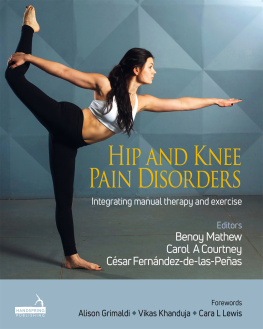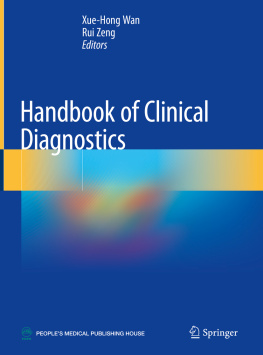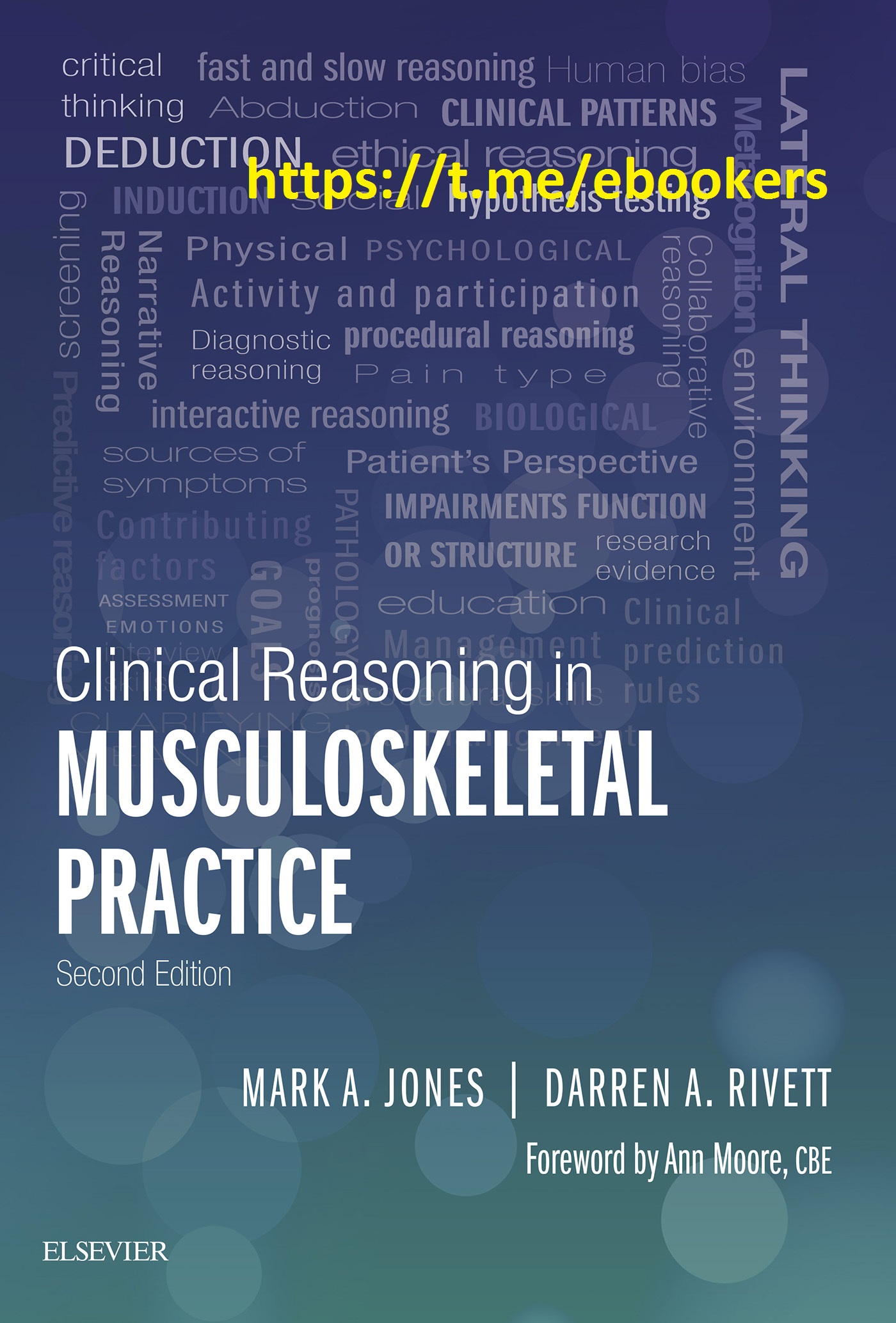Table of Contents
List of tables
- Tables in 1
- Tables in 3
- Tables in 5
- Tables in 7
- Tables in 8
- Tables in 9
- Tables in 10
- Tables in 12
- Tables in 13
- Tables in 14
- Tables in 15
- Tables in 16
- Tables in 17
- Tables in 18
- Tables in 21
- Tables in 23
- Tables in 27
- Tables in 28
- Tables in 29
- Tables in 30
- Tables in 31
List of figures
- Figures in 1
- Figures in 3
- Figures in 4
- Figures in 5
- Figures in 6
- Figures in 7
- Figures in 8
- Figures in 9
- Figures in 10
- Figures in 11
- Figures in 12
- Figures in 13
- Figures in 14
- Figures in 15
- Figures in 16
- Figures in 17
- Figures in 18
- Figures in 19
- Figures in 20
- Figures in 21
- Figures in 22
- Figures in 23
- Figures in 24
- Figures in 25
- Figures in 26
- Figures in 27
- Figures in 28
- Figures in 29
- Figures in 30
- Figures in 31
Landmarks
Clinical Reasoning in Musculoskeletal Practice
SECOND EDITION
MARK A JONES BSc(Psych) PT GradDipManipTher MAppSc
Senior Lecturer, Program Director, Master of Advanced Clinical Physiotherapy, School of Health Sciences, University of South Australia, Adelaide, Australia
DARREN A RIVETT BAppSc(Phty) GradDipManipTher MAppSc(ManipPhty) PhD
Professor, School of Health Sciences, University of Newcastle, Callaghan, New South Wales, Australia
FOREWORD BY
ANN MOORE CBE
Professor Emerita, School of Health Sciences, University of Brighton, Brighton, UK
Director of the Council for Allied Health Professions Research (CAHPR)

EdinburghLondonNew YorkOxfordPhiladelphiaSt LouisSydneyToronto2019
For Elsevier
Content Strategist: Poppy Garraway, Serena Castelnovo
Content Development Specialist: Sally Davies, Veronika Watkins
Senior Project Manager: Manchu Mohan
Designer/Design Direction: Bridget Hoette
Illustration Manager: Nichole Beard
Table of Contents
Copyright

2019 Elsevier Ltd. All rights reserved.
No part of this publication may be reproduced or transmitted in any form or by any means, electronic or mechanical, including photocopying, recording, or any information storage and retrieval system, without permission in writing from the publisher. Details on how to seek permission, further information about the Publisher's permissions policies and our arrangements with organizations such as the Copyright Clearance Center and the Copyright Licensing Agency, can be found at our website: www.elsevier.com/permissions.
This book and the individual contributions contained in it are protected under copyright by the Publisher (other than as may be noted herein).
First edition 2004
Second edition 2019
ISBN 978-0-7020-5976-6
e-ISBN 978-0-7020-5977-3
British Library Cataloguing in Publication Data
A catalogue record for this book is available from the British Library
Library of Congress Cataloging in Publication Data
A catalog record for this book is available from the Library of Congress
Notices
Knowledge and best practice in this field are constantly changing. As new research and experience broaden our understanding, changes in research methods, professional practices, or medical treatment may become necessary.
Practitioners and researchers must always rely on their own experience and knowledge in evaluating and using any information, methods, compounds, or experiments described herein. In using such information or methods they should be mindful of their own safety and the safety of others, including parties for whom they have a professional responsibility.
With respect to any drug or pharmaceutical products identified, readers are advised to check the most current information provided (i) on procedures featured or (ii) by the manufacturer of each product to be administered, to verify the recommended dose or formula, the method and duration of administration, and contraindications. It is the responsibility of practitioners, relying on their own experience and knowledge of their patients, to make diagnoses, to determine dosages and the best treatment for each individual patient, and to take all appropriate safety precautions.
To the fullest extent of the law, neither the Publisher nor the authors, contributors, or editors, assume any liability for any injury and/or damage to persons or property as a matter of products liability, negligence or otherwise, or from any use or operation of any methods, products, instructions, or ideas contained in the material herein.



Printed in China
Foreword
This book, Clinical Reasoning in Musculoskeletal Practice, is the second edition of a book published in 2004 by Mark Jones and Darren Rivett. The title of the first version was Clinical Reasoning for Manual Therapists. It is very welcome to see the development of this title recognizing the spread of approaches that musculoskeletal physiotherapists now take in addition to manual therapy which is still an important and fundamental approach. The book is of extreme relevance and importance to all practitioners dealing with musculoskeletal issues in clinical practice on a daily basis. The book is also highly relevant for clinical educators; academics focused on musculoskeletal science and practice in educational, as well as clinical settings; and, of course, for students, whether at undergraduate or postgraduate level.
It is exciting to see how clinical reasoning and decision-making theories have developed over the last 15 years or so, and this book captures these theoretical developments and also captures the clinical relevance and applications of these theories. Mark Jones and Darren Rivett have very successfully brought together 52 authors who are well known in the field of musculoskeletal physiotherapy. Importantly, the authors are based in 12 countries from across the world, which thus represents an international perspective on clinical reasoning.
The book contains three sections. Section 1 contains five chapters which focus on key theories which inform clinical reasoning in musculoskeletal practice. This section is a fundamental read before moving on into the next section: Clinical Reasoning in Action: Case Studies From Musculoskeletal Practitioners. Section 2 consists of 25 chapters with each one focusing on a different musculoskeletal condition and demonstrating considerable complexities. Each case study includes a history of the patient's condition, examination findings, their treatment approaches, and their outcomes. In addition Mark Jones and Darren Rivett worked with the lead author of each of these chapters to explore their clinical reasoning throughout the case study, and finally, they provide a clinical reasoning commentary which links the clinician's reasoning to the five theoretical chapters in Section 1.



















